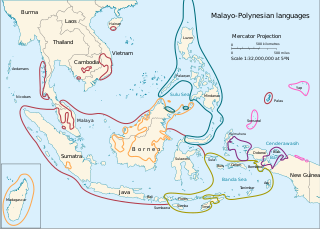Related Research Articles

The Malayo-Polynesian languages are a subgroup of the Austronesian languages, with approximately 385.5 million speakers. The Malayo-Polynesian languages are spoken by the Austronesian peoples outside of Taiwan, in the island nations of Southeast Asia and the Pacific Ocean, with a smaller number in continental Asia in the areas near the Malay Peninsula, with Cambodia, Vietnam and the Chinese island Hainan as the northwest geographic outlier. Malagasy, spoken on the island of Madagascar off the eastern coast of Africa in the Indian Ocean, is the furthest western outlier.

Tok Pisin, often referred to by English speakers as New Guinea Pidgin or simply Pidgin, is an English creole language spoken throughout Papua New Guinea. It is an official language of Papua New Guinea and the most widely used language in the country. However, in parts of the southern provinces of Western, Gulf, Central, Oro, and Milne Bay, the use of Tok Pisin has a shorter history and is less universal, especially among older people.
The East Papuan languages is a defunct proposal for a family of Papuan languages spoken on the islands to the east of New Guinea, including New Britain, New Ireland, Bougainville, Solomon Islands, and the Santa Cruz Islands. There is no evidence that these languages are related to each other, and the Santa Cruz languages are no longer recognized as Papuan.

The approximately 450 Oceanic languages are a branch of the Austronesian languages. The area occupied by speakers of these languages includes Polynesia, as well as much of Melanesia and Micronesia. Though covering a vast area, Oceanic languages are spoken by only two million people. The largest individual Oceanic languages are Eastern Fijian with over 600,000 speakers, and Samoan with an estimated 400,000 speakers. The Gilbertese (Kiribati), Tongan, Tahitian, Māori and Tolai languages each have over 100,000 speakers. The common ancestor which is reconstructed for this group of languages is called Proto-Oceanic.
The Meso-Melanesian languages are a linkage of Oceanic languages spoken in the large Melanesian islands of New Ireland and the Solomon Islands east of New Guinea. Bali is one of the most conservative languages.
In linguistics, Melanesian is an obsolete term referring to the Austronesian languages of Melanesia: that is, the Oceanic, Eastern Malayo-Polynesian, or Central–Eastern Malayo-Polynesian languages apart from Polynesian and Micronesian. A typical classification of the Austronesian languages ca. 1970 would divide them into something like the following branches:
The Tolai language, or Kuanua, is spoken by the Tolai people of Papua New Guinea, who live on the Gazelle Peninsula in East New Britain Province.
Iwal is an Austronesian language spoken by about 1,900 people from nine villages in Morobe Province, Papua New Guinea. Although it appears most closely related to the South Huon Gulf languages, it is the most conservative member of its subgroup.
Takia is an Austronesian language spoken on Karkar Island, Bagabag Island, and coastal villages Megiar and Serang, Madang Province, Papua New Guinea. It has been syntactically restructured by Waskia, a Papuan language spoken on the island.
Amara is an Austronesian language spoken by about 1200 individuals along the northwest coast of West New Britain Province, Papua New Guinea on the island of New Britain. Speakers have close to 100% bilingualism with Bariai, and many also speak Tok Pisin.
Bukawa is an Austronesian language of Papua New Guinea.
Yabem, or Jabêm, is an Austronesian language of Papua New Guinea.
Uneapa is an Oceanic language spoken by about 10,000 people on the small island of Bali (Uneapa), north of West New Britain in Papua New Guinea. It is perhaps a dialect of neighboring Vitu. Uneapa is one of the most conservative Oceanic languages, having retained most of Proto-Oceanic's final consonants with an echo vowel, such as *Rumaq 'house' > rumaka and *saqat 'bad' > zaɣata.

Papua New Guinea, a sovereign state in Oceania, is the most linguistically diverse country in the world. According to Ethnologue, there are 840 living languages spoken in the country. In 2006, Papua New Guinea Prime Minister Sir Michael Somare stated that "Papua New Guinea has 832 living languages ."
The Reef Islands – Santa Cruz languages are a branch of the Oceanic languages comprising the languages of the Santa Cruz Islands and Reef Islands:

The North Halmahera (NH) languages are a family of languages spoken in the northern and eastern parts of the island of Halmahera and some neighboring islands in Indonesia. The southwestern part of the island is occupied by the unrelated South Halmahera languages, which are a subgroup of Austronesian. They may be most closely related to the languages of the Bird's Head region of West Papua, but this is not well-established.
Kove is one of the Austronesian languages of New Britain which is spoken by the people of Papua New Guinea. The language is found in 18 villages with their populations totaling 9,000 people; however, most of the people are unfamiliar with the language. Instead of using the Kove language, many of them use Tok Pisin as their daily language.
The Oirata–Makasae, or Eastern Timor, languages are a small family of Papuan languages spoken in eastern Timor and the neighboring island of Kisar.

Unea Island is an island in Papua New Guinea located in the Vitu Islands. It was occupied by Japan in World War II.
Tom Dutton was an Australian linguist specialising in Papuan languages and other languages of Papua New Guinea.
References
- ↑ Vitu at Ethnologue (18th ed., 2015) (subscription required)
- Ross, Malcolm D. (2002). "Bali–Vitu". In John Lynch; Malcolm Ross; Terry Crowley (eds.). The Oceanic languages. Richmond, Surrey: Curzon. pp. 362–386. ISBN 978-0-7007-1128-4. OCLC 48929366.
- Van den Berg, René; Peter Bachet (June 2006). "Retained and Introduced Final Consonants in Vitu". Oceanic Linguistics. 45 (1): 43–52. doi:10.1353/ol.2006.0001. OCLC 89063907. S2CID 144533700.
- Van den Berg, René (June 2007). "An Unusual Passive in Western Oceanic: The Case of Vitu" (PDF). Oceanic Linguistics. 46 (1): 54–70. doi:10.1353/ol.2007.0027. S2CID 145784179.